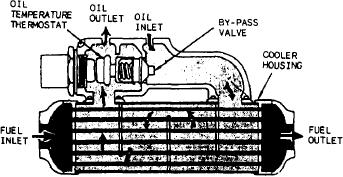
The most common methods of oil temperature
indicators are a thermocouple-type fitting or an
oil temperature bulb.
Vents
Vents are lines or openings to the atmosphere
in the oil tanks or accessory cases of the engine.
The purpose of the vent in an oil tank is to keep
the pressure within the tank from rising above or
falling below that of the outside atmosphere.
However, the vent may be routed through a
pressure relief valve that keeps pressure on the oil
Figure 5-13.-Fuel-oil heat-exchanger type of cooler.
system to assure positive flow.
In the accessory case, the vent (or breather)
is a screen-protected opening that allows
Oil Jets
accumulated air pressure to escape. The scavenged
oil carries air into the accessory case, and this air
must be vented. Otherwise, the pressure buildup
The oil jets (or nozzles) are located in the
within the accessory case would stop the flow of
pressure lines next to or within the bearing
oil draining from the No. 1 bearing. This oil
compartments and rotor shaft couplings. The oil
would be forced past the rear bearing oil seal and
from these nozzles is delivered as an atomized
into the compressor housing. Oil leakage could
spray. Some engines use an air-oil mist type of
nozzle spray. This air-oil mist is produced
cause any of several problems, including high oil
by tapping high-pressure bleed air from the
consumption, cockpit air contamination, or a fire.
compressor and mixing it with the oil. This
An oil leakage around the combustion area
method is adequate for ball and roller type of
or turbine area could cause burning and engine
bearings; however, the solid oil spray method is
failure.
The screened breathers are usually located in
better.
the front center of the accessory case to prevent
Some engines have "expendable oil" jets to
oil leakage through the breather. Some breathers
lubricate the bearings supporting the turbine rotor
have a baffle to prevent oil leakage during flight
shaft. The air-oil mist from such jets is not
maneuvers.
returned to the tank, but is discharged overboard.
A vent that leads directly to the No. 1 bear-
ing compartment may be used in some engines.
This vent equalizes pressure around the front
Gauge Connections
bearing surface. Then the lower pressure at the
first compressor stage will not force oil past the
Gauge connections are used in the oil system
No. 1 bearing rear carbon oil seal and into the
for oil pressure and oil temperature. The oil
compressor.
pressure gauge is usually a necessity in all systems
to measure the pressure of the lubricant. This is
Oil System Seals
done as it leaves the pump on its way to the oil
jets. Since oil pressure is the best indication that
Any system containing fluids need some type
the system is operating properly, the oil pressure
of seal to prevent fluid loss. The importance
gauge is vital.
of oil seals cannot be overemphasized! An
improperly installed or leaking seal in the oil
The oil pressure gauge connection is always
located in the pressure line between the pump and
system could cause bearing failure, fire, or cockpit
fumes. This could result in loss of aircraft or
the various points of lubrication. The oil
LIFE. There are three types of seals used in jet
temperature gauge connection may be located in
engine oil systems--synthetic, carbon, and
either the pressure or the scavenge line. However,
labyrinth.
the scavenge line is preferred, since this location
permits a more accurate indication of the actual
SYNTHETIC SEALS.-- Seals, packings, and
bearing temperatures, as the temperature of the
O-rings are used where metal-to-metal contact
oil is shown shortly after it leaves the bearings.
5-15

